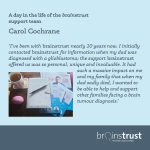Hello! I’m Molly, the London and South East Support Specialist and the Children and Family Support Officer. I work from home in Sussex, occasionally with my fluffy companion, Daisy, who is often curled up at my feet.
I joined brainstrust in March 2022 and I’ve enjoyed connecting with so many of you over this time. Most of you will have friends or family that you can reach out to, but how many of your find yourself holding back even just slightly to avoid burdening your loved ones? I get it, and that’s exactly why I’m here. It’s important to me that you feel there is someone that you can tell exactly how things are for you right now.
The brainstrust Support team is a small (but hugely productive) team of 7 who are responsible for delivering everything related to our support service. This includes our information production, events coordination and facilitation, coaching service as well as responding to emails and calls that come through our helpline. As a charity we balance being proactive with being reactive and being there for people when they need us the most.
Join me below as I talk you through what a day as Molly at brainstrust can look like:
*Names and certain details have been changed to protect the privacy of the individual.
 08:30 – 09:30 – After walking and feeding Daisy, it’s time to get started with work. I’ve always been a morning person, so I often spend the first hour firing through my to-do-list and my emails to make sure that anyone who has reached out to me overnight hears back first thing.
08:30 – 09:30 – After walking and feeding Daisy, it’s time to get started with work. I’ve always been a morning person, so I often spend the first hour firing through my to-do-list and my emails to make sure that anyone who has reached out to me overnight hears back first thing.
09:30-10:30 – We have a support team meeting where we talk about what’s going well, what we’re struggling with and the projects we’re currently working on. In this week’s meeting, I’m able to report that the know how I’ve been working on has now been launched on the website about ‘How to prepare for hospital discharge’ . These are 5-minute quick reads to help you feel more in control and better prepared for what’s ahead on your brain tumour journey.
10:30-11:00 – I pick up a helpline call from a patient called Lauren. There have been changes on her recent scan and she’s been offered the choice of surgery. She’s not feeling confident about going ahead with this plan as she’s heard about surgery cancellations at her particular hospital due to access to HDU beds. We talk through what she needs to feel safe and more confident in her clinical care and she decides that a second opinion and hearing what another hospital can offer would help. We talk though two options of being referred by her GP or having a private consultation with a hospital in London. Lauren is going to talk to her husband, and we’ll check in again in the next couple of days once she’s decided.
11:00-12:00 – I’ve been mapping out support centres in my region and today I’m reaching out to them. Some of these you may have already come across like the Maggie’s Centres at The Royal Marsden, Charing Cross, Bart’s and the Royal Free or some others like the Macmillan Horizon Centre in Brighton or the Fountain Centre in Guildford. Some are new to me so I’m saying hello and introducing our services. Some, I’ve been in touch with before so I’m checking in with them and seeing if they’d like a top up of any of our resources like our support catalogues or fatigue books.
12:00-12:30 – Lunchtime and out into the beautiful sunshine for a 17-minute loop around the park by my house.
12:30-13:00 – I hop onto the Facebook support group to have a quick read through to see what people are posting about and if I may be able to add any helpful or supportive comments. James has shared a poem that he’s written about his experiences, Tony has shared pictures of his recovery from surgery and Lucy is asking how she orders a brain box to have resources posted to her. I add a comment to let her know that she can order this through our resources page.
13:00-14:00 – I’m running the Meningioma Matters online meetup. It’s a great turn our today, we have 14 attending. It’s a very supportive and welcoming space. Linda who is new to the group is sharing that she’s had a difficult week with fatigue. John who has been to a few meetups before jumps in to reassure her that he also suffers with this and shares what he finds really helps him on the difficult days. Adam is new to the group and is asking whether he has to surrender his driving license. A few share about their experiences and I share a link to our driving know how in the chat box. Phoebe shares that she’s worried about her upcoming scan. Lots in the group offer her reassurance and I mention about our coaching offer to talk through her feelings of uncertainty and explain that I will ask her local Support Specialist to reach out to her to talk this through.
14:00-15:00 – I have a video call with Damon (I will use his real name here as he’s our lovely new peer supporter and soon to be volunteer coach). We talk through the possibility of presenting opportunities as he’s interested to do more public speaking. We talk about an upcoming wellbeing day in Brighton which he delighted to present at to talk about what’s made all the difference for him since his diagnosis. We also talk through talking at a school who is fundraising for us and wants us to speak in their assembly about the impact of a brain tumour diagnosis.
15:00-16:00 – I have a coaching call with Steve who is a dad to Millie who was diagnosed with a non-malignant brain tumour in 2021. He’s feeling overwhelmed at the moment as Millie is struggling with behaviour and personality changes. He’s having to focus a lot of his energy on supporting Millie and his family at the moment and is feeling conflicted with his core values as he doesn’t feel like he is achieving or help others. We talked through positive self-talk when he doesn’t feel like he’s achieving. We also worked through a chunking exercise to breakdown a realistic training programme towards his race in the summer where he is fundraising for brainstrust and Sheffield Children’s Hospital as he wants to help others facing the same as what his family has. This helped him to feel more aligned with his core values, less overwhelmed and more on top of things. We’re going to speak again in a months’ time.
16:00-16:30 – I hop back onto my emails to send a few replies and tick the last things off the to-do list before finishing for the day.
There is no such thing as an ‘average’ day at brainstrust (which is one of the things that I love). Our job is varied and busy but above all important. We couldn’t do the job we do without the support of our wonderful community, and for that, we are all so grateful.





